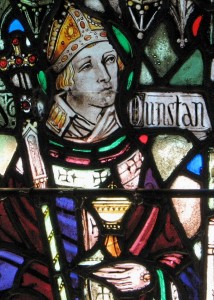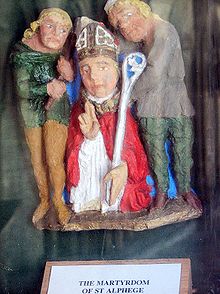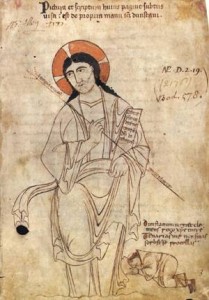A Saints’ Tale
Thumbing through my copy of Magnificat in church last week, I came upon the story of Saint Ethelfleda. Her tale breathes a warm, oddball humanity–in contrast to the usual Magnificat fare of sanctity, torture and grim death for aspiring saints.
Saint Ethelfleda is someone I can relate to: swims naked, prays outdoors, entertains generously, and inspires young people.
Here are her miracles of renown, and those of her teenage admirer – who went on to surpass her in weird tales.
Saint Ethelfleda (c.930 – Feast Day – October 23) was a member of the Anglo-Saxon nobility. Following the death of her husband, she spent the rest of her life as abbess of Romsey. Her devotional acts included chanting psalms while standing naked in the cold water of the River Test.
One day, as Ethelfleda was preparing for a visit from her kinsman, King Athelstan, the royal chamberlain arrived in advance to see if she had the provisions necessary to host the king and his large retinue. Upon being informed by the chamberlain that she lacked an adequate supply of ale, Ethefleda answered, “My patroness, the Virgin Mother, will send me an abundance of ale.” She thereupon withdrew to an oratory of the Blessed Virgin, where she ardently prayed for heavenly intervention.
When on the next day the king and his men arrived after attending Mass, Ethelfleda’s modest barrel of ale supplied all they wanted without running dry.
Her legend also tells that she spent time with the king and queen at court, where Ethelfleda’s habit–for “ascetic reasons” –of bathing in the nude at night was the occasion of the queen’s nervous illness, brought on by the queen’s “indiscreet curiosity” when she followed her to see where she went. The queen was afterward cured by the abbess’ intercession.
The Magnificat story ended by saying the elderly Ethelfleda was frequently visited by a teenage boy who drew inspiration from her example. The youth was the future abbot of Glastonbury and archbishop of Canterbury – Saint Dunstan.
Saint Dunstan (909?-May 19, 988, Feast Day – May 19) was born near Glastonbury and lived for a time in the household of Saint Ethelfleda’s kinsman, King Athelstan. The dreamy young man became a great favorite of the king, his relatives and other members of the court became jealous and envious. They accused Dunstan of studying heathen literature and black magic, and prevailed upon the king to order him to leave the court. 
As he was departing Dunstan was attacked. According to various accounts, he was beaten and thrown in a duck pond or cesspool, where his enemies pushed him face down in the muck.
He fled to Winchester and entered the service of Bishop Aelfheah the Bald, who endeavored to persuade him to become a monk. Dunstan was doubtful about whether or not he had the vocation to celibate life, but an outbreak of tumors all over his body–probably from blood-poisoning caused by the treatment to which he had been subjected, changed his mind. 
He made his profession at the hands of St. Aelfheah (“Elf-high”) and returned to live the life of a hermit at Glastonbury, working on his forge and playing his harp. Here the Devil is supposed to have appeared to tempt him, and Dunstan seized him with his blacksmith tongs and made him promise never to enter a house with a horseshoe over the doorway.
Dunstan also worked as a silversmith and in the scriptorium while he was living at Glastonbury. Dunstan drew his own self-portrait in the small, kneeling monk beside Christ in the Glastonbury Classbook. The inscription reads: “I ask you, merciful Christ, to watch over me, Dunstan. May you not permit the Taenarian storms to swallow me.” 
Did Saint Dunstan delve into occult practices in his youth? Perhaps. It has been speculated that his famous fight with the Devil was in fact a battle with his own desire to fully resume his former practices and studies.
The sketch in his own hand showing Dunstan holding the hem of Christ’s garment; and his petition for Christ’s aid to save him from the underworld–or Hell–may be more illuminating than we realize about his inner and outer life.
The “heathen literature” Saint Dunstan studied when he was younger may have been some Irish manuscripts describing druid practices and beliefs that survived Saint Patrick’s efforts at destroying all of them. His early education was received from Irish monks at Glastonbury. Dunstan obviously had access to manuscripts by Ovid or other ancient Greeks with his reference to “Taenarian storms” – Taenarius or Taenarus is the path or gateway to the underworld or Hades.
At least one person thought St. Dunstan might have practiced or dabbled in magic: William Godwin (1756-1836) , who included him in his book, Lives Of The Necromancers: Or An Account Of The Most Eminent Persons In Successive Ages, Who Have Claimed For Themselves, Or To Whom Has Been Imputed By Others, The Exercise Of Magical Power. The book was published in 1834. The other necromancer of ancient Britain Godwin cited was Merlin.
Goodwin asserted that at least one of Saint Dunstan’s “miracles” was really magic. As the story goes Eadmund, a young king of 18, sought the advice of Dunstan, but the jealousy of the courtiers was aroused and he was driven from court.
“For, a few days later, the king rode out to hunt the stag in Mendip Forest. He became separated from his attendants and followed a stag at great speed in the direction of the Cheddar cliffs. The stag rushed blindly over the precipice and was followed by the hounds. Eadmund endeavoured vainly to stop his horse; then, seeing death to be imminent, he remembered his harsh treatment of St. Dunstan and promised to make amends if his life was spared. At that moment his horse was stopped on the very edge of the cliff. Giving thanks to God, he returned forthwith to his palace, called for St. Dunstan and bade him follow, then rode straight to Glastonbury. Entering the church, the king first knelt in prayer before the altar, then, taking St. Dunstan by the hand, he gave him the kiss of peace, led him to the abbot’s throne and, seating him thereon, promised him all assistance in restoring Divine worship and regular observance.” (Catholic Encyclopedia)
At that time Dunstan was 19 or 20 years old. He became the Keeper of the Treasure and the chief adviser to the king. When his royal friend was stabbed in May 946 by the outlaw Leof, the abbot buried him in the abbey.
It sounds like a spell Merlin would have concocted to change the king’s heart.
A counselor to successive kings, Dunstan continued to have potentially fatal run-ins with them. On the day of his coronation in 956, newly crowned King Eadwig left his banquet to join two women in bed–the king’s foster-mother, and her daughter, Aelfgifu. Dunstan followed in a fury and dragged the startled king back to the hall and his knights. The episode, no surprise, led to Dunstan’s exile and flight for his life.
Besides the number of times he was thrown out of court and then restored, Dunstan’s life was notable for the number of visions of angels and demons, including a warning by angels that he would die within three days. He did.
“..for all his life this unique and marvellous man had revelation of things distant in space and in time, and his happy spirit, full of the artist, metal-worker, lover of tunes and gay, lived on the edge of this world; the good and the evil of the unseen supported and attracted him as they do such few as are placed on the outposts of humanity.” (Hilaire Belloc, History of England)

January 1st, 2010 at 1:42 pm
Love the stories of Dunstan. I have blacksmiths in my family background and am now seriously considering adopting Dunstan as their patron. I have been to Glastonbury and found it impressive along with a lot of that countryside.
All the best for 2010.
January 1st, 2010 at 2:14 pm
Dear Benny,
Happy New Year! Good health and good cheer in 2010!
Glad you like the Dunstan stories! The chance reading about St. Ethelfleda led me to him. As it turned out, Dunstan ended up being even more interesting a character than a naked saint in a stream. Happily, the church wasn’t able to rehabilitate them into totally saccharine mush!
November 29th, 2023 at 1:02 pm
I taught the stories of early England for years in my 12th grade English class, wanting to fill in the history before exploring the literature, making the two more relative to my students. I remember, and again, “remember” that Dunstan disliked “Edwy” and had him separated from his young wife. Further, he had her sent to the dungeon and had her face disfigured with a red hot iron. The story continues with her being shuttled off to Devonshire where her attendant told the people of Devonshire to dispose of her. The people of Devonshire instead took pity on her, healed her wounds, and they mended, leaving no signs of scarring. I leaned heavily on Charles Dickens’ book, A Childe’s History of England. Your writings brought it all back home to me, though I have been away from the classroom for over a decade, choosing to live in the mountains of Colorado on a river where my wife and I farm. And I have a forge, and I play guitar gigs downtown. I noticed the similarity to Dunstan, and I no longer see him in quite a villainous light. I also pray outdoors and swim naked when I get the chance. (Ethelfleda) Thank you for bringing it back to me.